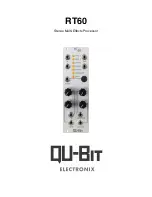
50
or additional speakers and amplifiers. Most loudspeaker manufacturers recommend an amplifier which provides 1.5 to 2
times the rated RMS power of the speaker. If the sound system is too loud when the mixer’s main faders are set to unity, this
indicates that you have more power than is required for the venue and you can simply turn down your mixer’s main output
faders until the desired performance level is achieved.
4. Balance The System’s Frequency Response
It’s now time to balance the system’s overall frequency response by fine-tuning the amplifier attenuators. This step is not
absolutely necessary, but is recommended as it can help smooth out the system’s frequency response before applying any
system EQ, which translates to smaller gain adjustments in the EQ and better sound quality. You can perform this procedure
while listening to your reference music and do it by ear, or use the dbx RTA-M reference mic and RTA. The music you choose
to use for reference should contain full-bandwidth audio and should be something you have spent much time listening to and
are extremely familiar with.
Since the gain structure is already set and the limiters calibrated, you will not want to raise your amplifier attenuators, as
we’ve already determined when we set the gain structure, setting them any higher will cause the amplifiers to prematurely clip.
Instead you will want to lower the amp attenuators for whichever frequency range (e.g., low, mid, etc.) is too loud. For example,
if the system has too much midrange, turn down your mid amp attenuators. If the system has too much high-end, turn down the
high amp attenuators. The goal is to achieve a balanced frequency response throughout the system.
TIP:
If you made any additional adjustments to amp attenuator settings in this step, you may want to make additional
marks around the attenuators to indicate these updated positions for future system use.
4. EQ The System In The Venue
Now that the system is optimized for use, it’s time to EQ the sound system in the venue. The VENU360’s built-in AutoEQ
Wizard does a great job of equalizing a sound system in a timely manner so we recommend using it. Once the AutoEQ Wizard
is complete, you can adjust the four “user” bands in the AutoEQ menu (bands 11-14) to add to the equalization. Or, if you
prefer, you can directly edit any of the 10 AutoEQ bands set by the AutoEQ Wizard (bands 1-10); if you want to get back to
the original settings set by the AutoEQ Wizard, just change the FLATTEN parameter from “MANUAL” back to “AUTOEQ”.
TIP:
Using AutoEQ bands 11-14 (“user” bands) to tailor the AutoEQ response to your liking allows the settings to be
retained even after subsequent runs of the AutoEQ Wizard. This means that each time you run the AutoEQ Wizard, your
manual “user” adjustments will automatically be applied on top of the AutoEQ’ed response curve. If you decide to manually
adjust AutoEQ bands 1-10, such manual settings will be wiped out each time the AutoEQ Wizard is run.
The following instructions can be used to fine-tune the system after running the AutoEQ Wizard or to manually EQ the sound
system in the event you don’t have the dbx RTA-M measurement microphone. Note that using the DriveRack VENU360 control
app on a mobile device allows you to walk around the venue while making EQ adjustments.
To EQ the system by ear:
1�
Choose a full-bandwidth music reference source that you are familiar with. Play the reference music through the sound
system. Turn the music up as close as possible to performance level (the level at which the system will be operated
during use).
2�
Walk around the venue and listen to the sound system. Does it sound thin, bright, or muddy? Try to get an overall
assessment of how the system sounds and what kind of improvements can be made.
3�
Go into the VENU360’s AutoEQ (AEQ) module and adjust the bands to taste. If you prefer to use graphic EQ rather
than parametric EQ, you can insert a GEQ module into one of the VENU360’s input insert slots using Configuration
mode, see
‘Configuring Processing Module Insert Types’ on page 25
. If using a GEQ to tune the system, try
each of the available QUICK CURVE options available in the menu to see if they get you close to the tone you’re after.
Содержание DriveRack VENU 360
Страница 1: ...Owner s Manual ...
















































